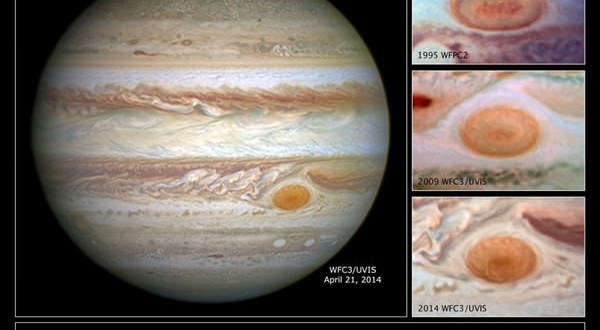Jupiter’s signature “Great Red Spot” is the strongest storm in the universe and it is shrinking, but scientists cannot determine the cause.
According to Space.com, the rate of its shrinking has sped up as it gets smaller and is now contracting at a rate of 580 miles per year. Scientists said it could have fit three Earths in it when it was its largest, but can now only fit our planet once.
According to Amy Simon of NASA’s Goddard Space Flight Center, the Great Red Spot now measures around 10,250 miles (16,500 km) across. Dating back to the late 1800s, historical observations noted that the Great Red Spot measures 25,500 miles (41,000 km) on its long axis. In 1979, the Great Red Spot cum swirling storm was observed by NASA’s Voyager 1 and Voyager 2 flybys to measure 14,500 miles (23,300 km) across.
In 1995, the Great Red Spot was estimated to be 13,020 miles (20,950 km) across based on a Hubble photo taken by Hubble’s Wide Field and Planetary Camera 2 (WFPC2). In 2009, the WFPC2 had been replaced by the Wide Field Camera 3 (WFC3) which took the photo of the storm and showed that it measured 11,130 miles (17,910 km) across.
Astronomers have followed this downsizing of the great red spot since the 1930s. In 2012, amateur observations saw a noticeable increase in the spot’s shrinking rate which is measured at 580 miles (930 km) every year. It was also seen as changing its shape from the original oval to the current circle.
The unexplained shrinkage of the Great Red Spot led Simon and her team to study the movements of the small eddies and internal dynamics of the storm. The team wanted to find out if the eddies that are entering the upwelling vortex have the capacity to feed or sap momentum.
“In our new observations, it is apparent that very small eddies are feeding into the storm,” said Simon in a press release. “We hypothesized that these may be responsible for the accelerated change by altering the internal dynamics and energy of the Great Red Spot.”
Agencies/Canadajournal

 Canada Journal – News of the World Articles and videos to bring you the biggest Canadian news stories from across the country every day
Canada Journal – News of the World Articles and videos to bring you the biggest Canadian news stories from across the country every day

